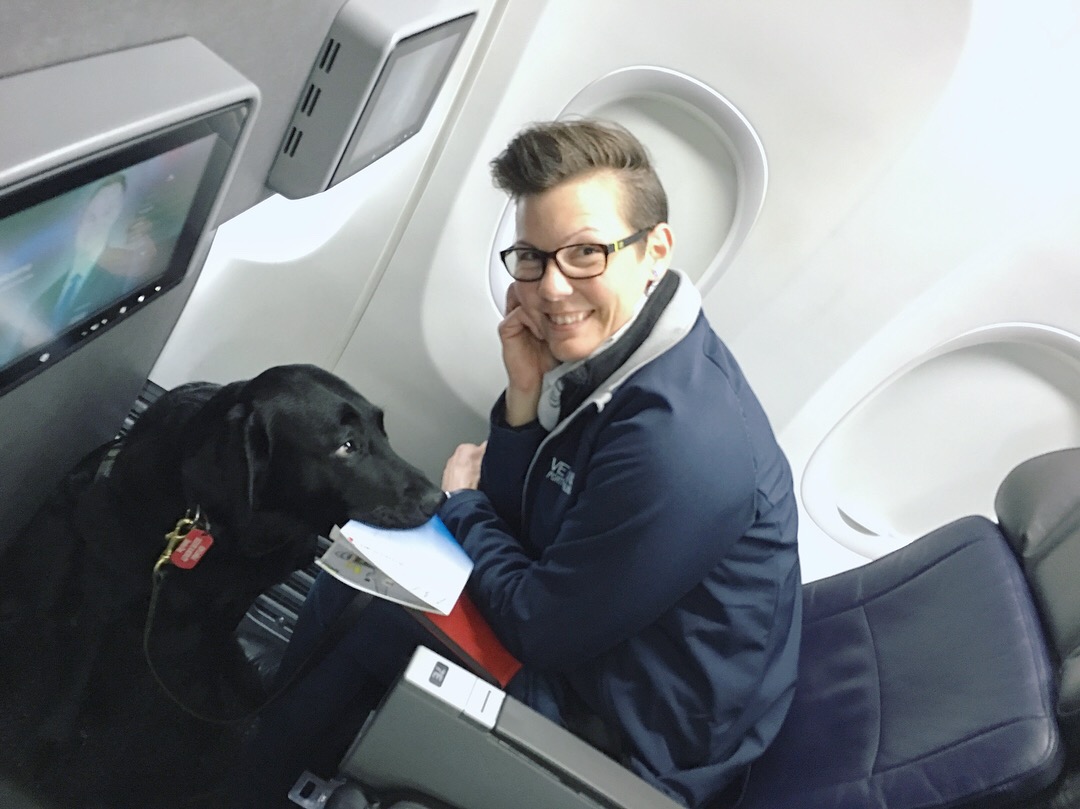Saints of Service: Emotional Support/Therapy and Service Dogs

Written by Julie Murray
As you know, in America, people have the tendency to take things a little too far. It can be great at times, like when it reminds us of the freedoms we enjoy to do so many things. It can also be harmful when it potentially gives something wonderful and special a bad name. Earlier this year, a woman attempted to board a flight with her “emotional support peacock”. While I do think it’s a little bizarre, I’m not judging her attachment to her pet. Heck, I had a hermit crab for a year when I was in my 20’s and I admittedly cried when he died. The thing I don’t like about this situation is how it may bring into question the importance of emotional support, therapy and service animals.
There are several differences between a service dog, an emotional support and a therapy dog. The American’s with Disabilities Act (ADA) defines service dogs as any guide dog or signal dog who is trained to provide assistance to an individual with a disability. Training is intense and usually takes anywhere from 18-24 months. Emotional Support Animals are companion animals that are certified by a medical professional to provide support to a person with a disability. This can include physical disabilities, but they are incredibly helpful to someone with psychiatric or intellectual disabilities as well. One main difference between an emotional support dog and a service dog is that the emotional support dog helps by providing affection and companionship to their owner, while a service dog is specially trained to help someone with a disability perform a task, for example, a seeing eye dog. A service dog is often picked by breed for certain characteristics, such as intelligence and drive while an emotional support dog does not need specialized training, and may come in all shapes, sizes and breeds. The third group, therapy dogs, have been trained, registered and insured to accompany their owners to visit patients and residents of hospitals and nursing homes to cheer up and soothe people. Training for these types of dogs usually takes about 8 weeks. As with emotional support dogs, they need not be a special breed, but they do require a bit more training and it is especially important for them to be well behaved.
The groups are also afforded different types of accessibility. According to federal law, the only two places that an emotional support dog is legally allowed is a “no pets allowed” apartment and the cabin of an aircraft. Also, you cannot just declare that your dog is your Emotional Support animal. There are certain steps you need to take if you want the protections afforded by federal law. First, you must have a note from a medical professional stating that you have a disability and could benefit from having an emotional support dog. Your dog is not required to have any special training, but it helps if they are well-behaved and respond to basic commands. They are not required to be registered, but they must have the proper documentation when searching for housing or boarding a plane. To qualify as a service dog, you must have a condition that falls within the Americans With Disabilities Act definition. The dog must be specifically trained to assist you with your disability. For example, if your dog has been trained to sense an anxiety attack, they will be able to take specific action to help avoid or lessen the attack. If the dog’s presence is merely to provide comfort in the event of such an attack, they would not qualify as a service animal. A therapy dog is, legally, still considered a pet. They are not allowed to go just anywhere, as with a service dog. They must have permission from the owner or manager of the facility. As I mentioned before, they must be registered and always carry their registration papers to show shop/restaurant owners and managers that the animal is well behaved, safe around people and insured against liability.
In a nutshell, a service dogs helps the owner perform tasks they cannot perform on their own, an emotional support dog helps improve the health of their disabled owner and a therapy dog works to improve the health and happiness of others. The one thing they have in common is a very special relationship between animal and owner – they care for and rely upon each other. Service and support dogs have a special ability to change lives for the better and provide the freedom to enjoy many activities that their owner's disability or emotional problem would otherwise deny them. They can also spread joy to a lonely resident of a nursing home or a scared and sick hospital patient with their wagging tails and happy demeanor. Whether it’s a blind person being able to finally live independently or a person with crippling anxiety finally being able to go out in public, dogs once again prove they are angels on Earth. What would we do without them? Let’s hope we never have to find out. :)




